
The global economy stands at a pivotal juncture in late 2025, grappling with persistent and deepening vulnerabilities within critical materials supply chains. This complex challenge, primarily driven by highly concentrated processing capabilities and escalating geopolitical tensions, has not only disrupted manufacturing but also unveiled unprecedented opportunities for strategic investors. Manufacturers worldwide are now abandoning short-term cost optimization in favor of multi-decade strategic planning, recognizing that supply chain resilience is no longer a luxury but a fundamental imperative for survival and growth. This paradigm shift signals a profound transformation in global trade, investment, and industrial policy, with long-term security and diversification taking precedence over immediate economic efficiencies.
Unraveling the Web of Dependency: A Detailed Look at Critical Materials Supply Chain Disruptions
The current landscape of critical materials supply chains is defined by a precarious dependency, largely centered around a handful of dominant players. As of late 2025, China's formidable, often overwhelming, share in the global processing and refining of numerous critical minerals remains the most significant vulnerability. According to the International Energy Agency's (IEA) Global Critical Minerals Outlook 2025, China refines 19 out of 20 vital strategic minerals, holding an average market share of 70%, and over 90% for global rare earth refining, reaching 99% for specific rare-earth minerals like dysprosium and samarium. This dominance extends to crucial battery minerals such as cobalt, lithium, and manganese, where China accounts for over 60% of global processing.
This concentrated control has increasingly been leveraged as a geopolitical instrument. Throughout late 2024 and into 2025, China imposed export restrictions and bans on materials vital for semiconductors, electric batteries, and defense technologies, including gallium, germanium, antimony, and graphite. While a temporary agreement in November 2025 suspended some restrictions on gallium, germanium, and antimony for the U.S., the underlying control through licensing requirements remains, highlighting the transient nature of such diplomatic solutions. Further expanding its reach, China included tungsten, tellurium, bismuth, indium, molybdenum, and seven heavy rare earth elements in its export controls in early 2025, and yttrium in April 2025. These actions have led to significant price surges and widespread concern across the aerospace, energy, and semiconductor industries. Nations like the United States and the European Union exhibit alarmingly high import reliance; the U.S. Geological Survey's 2025 list, now comprising 60 critical minerals, notes the U.S. is 100% net import-reliant for 15 minerals and imports over 80% of its rare earth elements. Similarly, the EU remains heavily dependent on third countries for strategic raw materials. This concentrated supply chain is highly susceptible to price volatility and sudden shocks, with a sustained disruption in battery metals potentially increasing global average battery pack prices by 40-50%. Despite public commitments, diversification efforts for refined materials have seen limited progress, with China driving 70-80% of supply growth for copper and lithium between 2020 and 2024.
The immediate implications for global manufacturing have been severe. Raw material shortages are directly impeding production in critical sectors such as automotive, electronics, and aerospace, leading to reduced output, elevated manufacturing costs, and persistent supply chain bottlenecks. For instance, China's restrictions on rare earth magnets could significantly disrupt global e-motor production and escalate electric vehicle (EV) costs. Furthermore, unreliable access to strategic minerals creates significant bottlenecks for innovation, particularly in emerging technologies essential for the green and digital transitions, potentially delaying deployment and impacting national competitiveness. Geopolitical risks are intensifying as the weaponization of critical minerals by dominant suppliers forces companies to fundamentally re-evaluate sourcing strategies, integrating national security imperatives alongside traditional cost-efficiency metrics. This has spurred a significant shift in strategic investment, with capital increasingly flowing into projects in allied or neutral nations to build redundant supply chains. End-users in sectors like automotive, defense, and technology are also pursuing upstream supply chain security through direct investments in mining companies or negotiating forward offtake agreements.
Navigating the New Terrain: Winners and Losers in the Critical Materials Race
The ongoing recalibration of critical materials supply chains is poised to create distinct winners and losers within the global market. Companies positioned to thrive are those actively involved in the domestic or allied-nation extraction, processing, refining, and recycling of critical minerals. This includes mining operations in countries like Australia, Canada, and the United States, as well as firms developing advanced technologies for efficient and environmentally sound extraction and processing. For example, MP Materials Corp. (NYSE: MP), a rare earth materials company with operations in Mountain Pass, California, stands to benefit significantly from renewed U.S. government and industry focus on domestic rare earth supply chains. Similarly, lithium producers like Albemarle Corporation (NYSE: ALB) and Livent Corporation (NYSE: LTHM), with diverse global operations and expansion plans outside of China, could see increased demand and strategic partnerships as manufacturers seek to diversify their battery material sourcing. Recycling technology firms, such as Redwood Materials (private), which focuses on battery recycling, are also set to gain as the circular economy for critical materials gains traction, driven by regulatory mandates like the EU's Critical Raw Materials Act. These "winners" will likely see new revenue streams, enhanced strategic partnerships, substantial government support, and increased market valuations as their role in securing vital supplies becomes indispensable.
Conversely, companies heavily reliant on single-source critical materials from China, particularly those that have not yet diversified their supply chains or committed to long-term resilience planning, face considerable risks. Manufacturers in sectors like consumer electronics, specialized industrial machinery, and certain automotive segments, which have historically optimized for cost without sufficient regard for geopolitical risk, could experience significant losses. These "losers" may confront increased input costs, severe production disruptions, and a loss of market share as competitors with more robust supply chains gain an advantage. Their vulnerability will be exacerbated by a potential inability to secure long-term contracts for essential materials, leaving them exposed to volatile spot markets and geopolitical whims. The imperative for adaptation is clear: companies that fail to pivot towards diversified sourcing, invest in material substitution R&D, and integrate supply chain resilience into their core corporate strategy risk being left behind in this rapidly evolving landscape.
A Broader Canvas: The Wider Significance of Supply Chain Resilience
The current vulnerabilities in critical materials supply chains are not isolated incidents but rather symptomatic of broader industry trends and geopolitical shifts. This event is a powerful accelerant for the global movement towards "de-risking" and "friend-shoring," where nations and corporations seek to reduce reliance on potentially adversarial or unstable supply sources by relocating production to allied or geographically proximate countries. It underscores the growing importance of a circular economy, with significant investments now flowing into recycling and recovery initiatives to establish robust secondary markets for critical materials. This shift also signals a resurgence of national security industrial policy, where governments actively intervene through grants, incentives, and strategic partnerships to build domestic capabilities in critical sectors.
The potential ripple effects are far-reaching. Competitors and partners across various industries, from defense to renewable energy, are being compelled to reassess their own supply chain vulnerabilities and accelerate diversification efforts. This will likely spur increased research and development in material science, fostering innovation in alternative materials and more efficient processing technologies. Global trade patterns are set to undergo a fundamental restructuring, moving away from purely cost-driven models to those prioritizing security and resilience. Regulatory and policy implications are already evident, with significant legislative actions such as the U.S. "Critical Materials Future Act of 2025" (S.596), which aims to establish a pilot program for domestic critical material processing. The European Union's Critical Raw Materials Act (CRMA), which entered into force in May 2024, is a landmark piece of legislation, designating 34 materials as critical and setting ambitious 2030 benchmarks: 10% local extraction, 40% processing within the EU, and 25% from recycled materials, while limiting sourcing of any single strategic material from a single third country to 65%. These policies are accompanied by substantial governmental financial support, tax incentives, and streamlined permitting processes to de-risk investments in diversified critical mineral projects. Historically, these events echo the oil crises of the 1970s, which forced a global reckoning with energy dependence, and more recently, the semiconductor shortages during the COVID-19 pandemic, both highlighting the profound fragility inherent in highly concentrated and interdependent supply chains.
The Road Ahead: Navigating Short-Term Volatility and Long-Term Transformation
Looking ahead, the critical materials landscape promises both continued short-term volatility and a profound long-term transformation. In the immediate future, market participants should anticipate ongoing price fluctuations for key materials, driven by geopolitical developments, new export restrictions, or unforeseen supply disruptions. This environment will likely accelerate investments in alternative sources and technologies, as companies and nations scramble to build resilience. Geopolitical maneuvering, including strategic alliances and trade disputes centered on mineral access, will also intensify. In the long term, however, the trajectory points towards more diversified and regionalized supply chains, characterized by stronger domestic capabilities across the entire critical mineral value chain, from extraction to processing and recycling.
Strategic pivots and adaptations are now non-negotiable for manufacturers. They must diversify their sourcing networks, actively invest in research and development for material substitution, and integrate comprehensive supply chain resilience into their core corporate strategies, moving beyond a purely just-in-time approach. Governments, in turn, will need to sustain and expand their policy support, financial incentives, and international cooperation efforts to foster a more secure and diversified global supply. This creates significant market opportunities in mining, advanced processing technologies, and recycling infrastructure, but also presents challenges such as managing higher initial investment costs, securing a skilled workforce, and navigating complex regulatory frameworks. Potential scenarios include a critical materials landscape that is more secure and environmentally sustainable, albeit potentially more expensive, alongside continued competition for resources, but with a stronger emphasis on ethical sourcing and responsible governance.
The Dawn of a New Era: A Resilient Future for Critical Materials
In summary, the growing vulnerabilities in critical materials supply chains represent a fundamental inflection point for global manufacturing and strategic investment. The past few years, culminating in the events of late 2025, have unequivocally demonstrated that critical materials are not merely commodities but strategic assets vital for national security, economic competitiveness, and the transition to a green economy. The market moving forward will be characterized by dynamic shifts, driven by geopolitical considerations, rapid technological innovation, and an unwavering commitment to sustainability. The era of optimizing for cost alone is over; resilience, diversification, and strategic autonomy are now paramount.
The lasting impact of this period will be a more robust, but also more complex, global supply chain architecture. Investors should closely monitor several key indicators in the coming months: the progress of strategic projects, such as the 47 EU strategic projects and various U.S. domestic initiatives for critical mineral development; policy developments and the implementation of legislation like the CRMA; merger and acquisition (M&A) activity in the mining, processing, and recycling sectors; and breakthroughs in advanced materials and recycling technologies. The shift towards multi-decade strategic planning for supply chain resilience is not a temporary trend but a foundational change, heralding a new era where securing access to critical materials will dictate the future of industries and economies worldwide.
This content is intended for informational purposes only and is not financial advice







